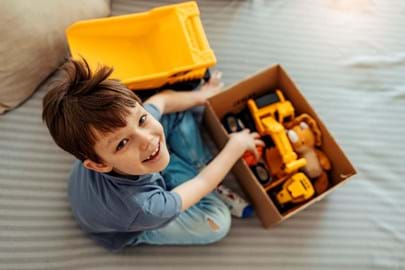
My four year old daughter Ava loves imaginative play. She cooks elaborate meals for her toys with her vintage timber toy stove, and loves shopping for her ‘children’ at her wooden shop filled with wooden groceries. But by the time she’s done, she’s played several different characters (tipping her dress ups across the floor) with a trail of ‘children’, wooden croissants and cupcakes behind her. And that’s just ‘that’ game, one of many played on any one day. When it comes time to tidy, she gets overwhelmed at the mess and, well, we both get a tad upset….
After surveying my daughter’s bedroom floor recently (or lack thereof as I couldn’t see the floor), I decided it was time to attempt a system for us to better manage her toys (and my stress levels).
Toy rotation
I realised I was doing Ava a disservice by giving her access to all her toys at once. She was overwhelmed, overstimulated, and not dedicating quality time to any one toy. My mum suggested I give toy rotation a try. By removing some of the toy options, my daughter could focus on one toy at a time. This would also simplify tidying up as there would be less to put away. I decided to give it a go.
I happened to have matching cardboard boxes the perfect size to stack inside Ava’s wardrobe. I grouped all the toys into piles and labelled each box to hold a different theme. One box was dedicated to ‘My Little Pony’, another box to dolls clothes, another to Peppa Pig and so on until all boxes were filled and labelled. After I stacked the boxes up out of reach, I explained (as enthusiastically as I could) the new system to Ava.
The rules:
- Play with whatever you like, when you like. Simply ask for the box to be taken down.
- When you’re finished, pack it back into the same box it came out of before asking for another box or toy.
 The trick was to only ever have one box down at a time. On the first day of this new system Ava asked for three different boxes to play with, but each time, she easily packed it away before the next box came down. We swiftly went from feeling overwhelmed and stressed to feeling excited by a system that was oh-so-easy to pack up.
The trick was to only ever have one box down at a time. On the first day of this new system Ava asked for three different boxes to play with, but each time, she easily packed it away before the next box came down. We swiftly went from feeling overwhelmed and stressed to feeling excited by a system that was oh-so-easy to pack up.
The official ‘toy rotation’ technique is to pack away most toys completely out of sight and rotate them every week or couple of weeks at the discretion of the parent. However, I wanted to empower my daughter with her involvement. Our version meant Ava was in control of the rotation with my assistance and could pick and choose what she wanted.
The wooden shop and kitchen are always accessible, but I’m working on reducing the kitchen accessories and ‘shop stock' to make these easier to keep tidy. The dress up box is also within reach, but simple to pack away and a daily joy I didn’t want to remove.
I also have large tubs of toys in our living area cupboards within Ava’s reach but behind closed doors. They are awkward for my daughter to access, so I’ll include these as ‘rotation’ options too. I have a tub dedicated to wooden blocks, one to a wooden railway set and two large tubs filled with Duplo. Currently, these come out once a month, but I’m hoping with the other toys now out of reach they will be rotated more frequency. The goal? All of Ava’s toys will get more airplay, meaning more satisfaction with the current toy assortment, and less desire to purchase new toys.
Benefits of toy rotation
Save money
Instead of buying new toys, kids appreciate what they have with renewed enthusiasm for old toys. Allocated space only for existing toys (i.e. no space for more) means new toys will have to replace old toys in order to fit. My daughter will have the choice of letting go of cherished toys if she wants new toys. With this method we are spending longer periods playing at home and less time being ‘bored’ asking to go out. We go to parks regularly, but we don’t go shopping to kill time or to browse. Temptation is out of reach for both of us and the desire or need for new stimulus is gone.
 Overwhelm is reduced
Overwhelm is reduced
Instead of being overwhelmed by too much choice kids have a limited selection of toys to enjoy one by one.
Easier to tidy
A smaller assortment of options makes for easier tidying. Alternative toys are brought out after existing toys are packed up.
Cultivates a longer attention span
No more being distracted by all the other toys within sight. Boredom is reduced due to high rotation and increased novelty with improved ability to focus on a single task.
Cultivates creativity and connection
Fewer toys means finding new, varied and meaningful ways to play with them. This builds connection with, and appreciation for, each toy.
More sustainable
Less toys are more sustainable and introduces mindful consumption to kids. Existing toys have lasting and more sustained appeal. Putting away toys for a while before reintroducing them means the toy is ‘like new’ again and enjoyed over a longer period. Each toy gets a longer ‘run’ before it’s time to pass it on, making it a better investment.
 Easier to declutter
Easier to declutter
This method helps to identify which toys are no longer enjoyed as much as others. Toys not being asked for can eventually be eliminated from the rotation and be donated or sold.
Less is more
Kids tend to cherish a smaller handful of toys more than a large assortment. This will help children to foster appreciation for simplicity as they grow up.
After the success in the bedroom I also packed up the bath toys, removing all but a sentimental boat we’ve had since my 9 year old son was a baby. Instead of playing with this, my daughter asked to play with a plastic jar of rocks my son had collected. What resulted was 20 minutes of deeply engaged bath play. The plastic (ex-honey) jar served as a vessel to fill and tip with and the little collection of coloured rocks ended up becoming characters in a fully developed storyline with drama and near death! One of the rocks had fallen off a cliff, ‘but it didn’t die mummy because this rock saved it’. I was gob smacked with how entertained she was with a handful of mere rocks. The jar is now permanently left near the bath and even features at bath time for my 9 year old. A timely and rewarding example of how little kids actually need to be entertained, occupied and inspired.
Perhaps the greatest gift we can give our kids is not a truck loads of toys, but instead empty space and ample time to fill it with their imagination in wild and wonderful ways.
Alison Gallagher is a freelance writer, resourcefulness expert and entrepreneur. She has been featured in various publications including Stellar Magazine, Australian Health and Fitness Magazine, and Cleo Magazine. Alison is particularly passionate about sharing practical tips on how to live simply, sustainably and seasonally.







